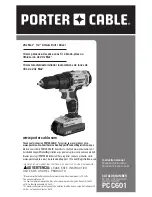
Page 12
SKU 97907
For technical questions, please call 1-800-444-3353.
Metal Drilling
Use high speed steel, carbide or spe-
1.
cialty bits for metal drilling.
Turn the Drill / Impact Selector Switch
2.
to “Drill”. Do not use the impact func-
tion when drilling metal.
Secure the work piece to keep it from
3.
moving during the drilling operation.
Use a punch to create a dimple for
4.
the bit to start.
Start by drilling slowly to keep the bit
5.
from running away from your starting
point.
As the hole is established, increase
6.
tool speed. Do not go so fast or use
so much pressure that the bit heats
up. This can damage the bit and cre-
ate an irregular hole. For hard metal,
use cutting oil to keep the bit cool.
Since drilling in metal is a slow opera-
7.
tion, you may lock the Trigger in the
ON position to maintain a constant
speed and reduce fatigue.
When drilling large holes in metal,
8.
start by drilling a smaller pilot hole,
then using a larger bit for the final
size hole.
Wood Drilling
Use high carbon, high speed steel
1.
bits or bits specially designed for
wood drilling, such as brad point,
spade bits, forstner bits, etc.
Turn the Drill / Impact Selector Switch
2.
to “Drill”. Do not use the impact func-
tion when drilling wood.
Secure the work piece to keep it from
3.
moving during the drilling operation.
Start by drilling slowly to keep the bit
4.
from moving away from your starting
point. Increase speed as the hole is
established.
To prevent or reduce “break out”
5.
when the bit penetrates the work
piece, clamp a piece of scrap wood to
the back of the work piece.
Do not lock the Trigger in the ON
6.
position, as the bit can easily jam in
wood and the motor must be stopped
quickly.
Masonry Drilling
Use specially designed masonry bits,
1.
such as Carbide bits when drilling
masonry. Ordinary bits will not work.
Turn the Drill / Impact Selector Switch
2.
to “Drill/Hammer”.
When drilling softer masonry, such
3.
as plaster or brick, use light pressure
and medium speed.
When drilling hard materials such as
4.
concrete, use additional pressure and
high speed.
When drilling tile, experiment on a
5.
scrap piece before starting. Tile is
brittle and may break if not handled
properly. You may need to use the
“Drill” only setting. You may need to
use special abrasive bits.













































